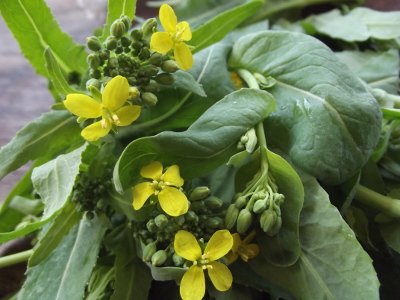
Turnip raab
 When
we started eating our Hakurei turnips in November, Daddy admonished me, "Don't
eat the turnips, eat the greens all winter long." So I left them
alone to see what would happen.
When
we started eating our Hakurei turnips in November, Daddy admonished me, "Don't
eat the turnips, eat the greens all winter long." So I left them
alone to see what would happen.
I was disappointed when
my turnips didn't put out many more leaves, but that's to be expected
since our Persephone
Days were beginning
by the time I cut the turnip tops the first time. Then, this
week, I discovered the real treat from overwintering turnips ---
"turnip raab" (aka "almost broccoli raab").
Despite the name,
broccoli raab is actually most closely related to turnips. Also
known as rapini, the vegetable is grown primarily for the unopened
flower buds, which can be cut repeatedly and which taste a bit like
broccoli. I haven't had good luck with broccoli raab in the past
--- it seems to bolt quickly and barely give me much of a harvest ---
so I stick to real broccoli.
That said, the flower
buds on my turnips were delicious, and the plants seem to be following
the lead of their relatives by sending out side shoots once I cut the
main head.  We've been eating bolted
mustard buds for a few weeks now, but the turnip buds are clearly a cut
above, with thicker stalks that don't go woody as quickly.
We've been eating bolted
mustard buds for a few weeks now, but the turnip buds are clearly a cut
above, with thicker stalks that don't go woody as quickly.
The moral of the story
is --- if you have overwintering turnips, go out and check on them now
for some bonus broccoli raab. The buds are best before they open,
but even young flowers like this are pretty tasty when you saute with
some mustard leaves and a bit of balsamic vinegar and peanut oil.
Whatever you do, don't pull out the bolting plants and consider them a
loss!
Want more in-depth information? Browse through our books.
Or explore more posts by date or by subject.
About us: Anna Hess and Mark Hamilton spent over a decade living self-sufficiently in the mountains of Virginia before moving north to start over from scratch in the foothills of Ohio. They've experimented with permaculture, no-till gardening, trailersteading, home-based microbusinesses and much more, writing about their adventures in both blogs and books.
Want to be notified when new comments are posted on this page? Click on the RSS button after you add a comment to subscribe to the comment feed, or simply check the box beside "email replies to me" while writing your comment.

Molly --- I'm with you on the roots of turnips. Sometimes I'll cook them up, but more often I'm not all that tempted. Carrots seem to be my favorite root crop, so I tend to focus on them.
Have you grown broccoli raab elsewhere with better success? Maybe that explains why people sing its praises so much and I think it's so useless.
In reference to your question about which plants I put my turnips near: We love broccoli and winter greens so much that it's always difficult to find a bed for crucifers. So, I actually decide on their location very simply --- any bed where there hasn't been a crucifer in two years is going to be a crucifer bed this year! Unfortunately, that leaves me no room for more intricate decisions like companion planting.